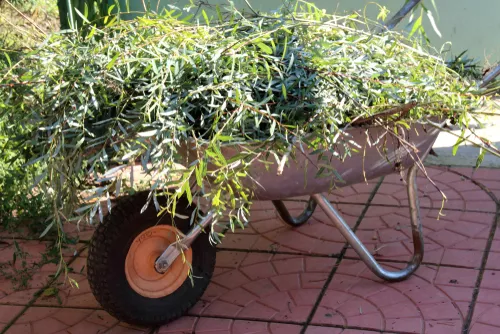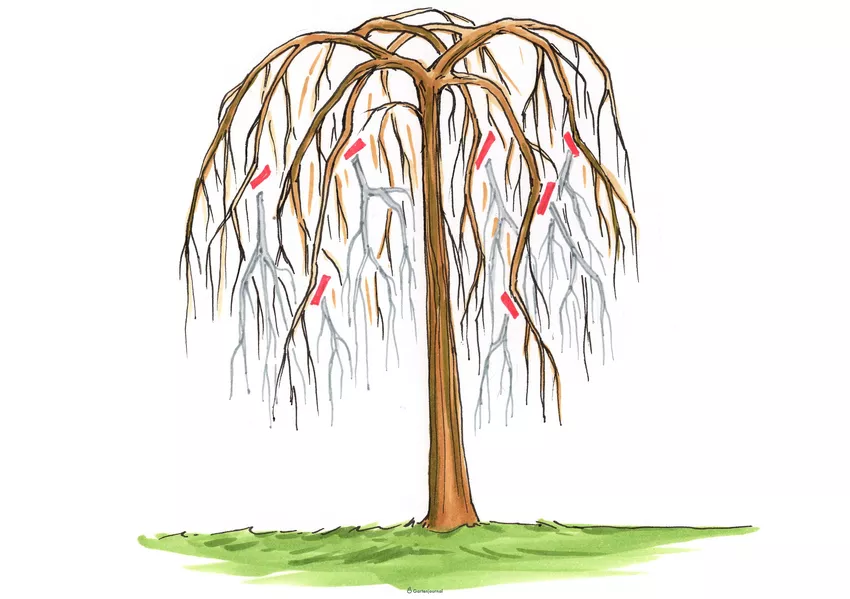- Best time is in February
- Prune ornamental willow annually
- Moderate summer cut is allowed
- Cut pollard willow - that's how it works
- Wound closure agents are taboo
- Rarely cut weeping willow
- frequently asked Questions
With up to 150 centimeters per year, the willow is one of the growth rockets in the garden. Regular pruning is therefore mandatory for the most beautiful species and varieties. In this tutorial, read when and how to properly cut ornamental willows, pollarded willows and weeping willows.
 Each willow species has its own pruning time
Each willow species has its own pruning time
Table of Contents
Show all- Best time
- Cut ornamental willow
- cut pollard
- Cut weeping willow
- frequently asked Questions
- Thoroughly thin out the shrub or crown
- Cut off deadwood, weak, inward-pointing or crossing shoots at the base
- Cut back the remaining branches by one third, half or two thirds
- Observe cutting direction on buds, 2-3 mm above an eye
- Ideally, excessively long shoots should be diverted to a lower-positioned young shoot on the side
- The best time is in winter from November to the end of February
- Cut off any branches growing out of the head
- Don't leave long stubs
- Remove shoots from the trunk all year round and promptly
- Cut weeping willow every 6 to 8 years
- The best time is between November and February when the weather is mild and dry
- Thin out dead, bare branches at the beginning on Astring
- Cut back drooping shoots to a flat side shoot
- Avoid large cuts greater than 3 cm in diameter
Best time is in February
In the private garden has the month February emerged as the ideal time for the Pruning care on pastures. For the gardener, the date scores with a good overview of the structure and arrangement of the shoots, because they are not yet in leaf at the end of winter. The trees themselves are in the transition from the winter sap dormancy to the beginning of budding, so that pruning measures have a gentle effect. Last but not least, a late winter pruning date conforms to the protection of nature and the regulations in the Federal Nature Conservation Act.
Choose a day with cloudy skies and dry weather. The temperatures should be in the frost-free range. As a lower tolerance limit, - 5 degrees Celsius has been proven in practice.
Prune ornamental willow annually
Ornamental willows flirt with elegantly hanging branches or shine in colorful foliage. Hobby gardeners have long succumbed to the charm of catkin willow, harlequin willow or corkscrew willow. To ensure that the decorative willow varieties present themselves from their most beautiful side every year, pruning care plays a key role. How to cut an ornamental willow masterfully:
The good-natured pruning tolerance of a willow allows a wide range of discretion. Trim the crown of a harlequin willow by up to two thirds to encourage rich colour. Ornamental willow 'Hakuro Nishiki' has the most beautiful green-white-pink colored leaves on this year's shoots. A corkscrew willow should at least be thinned out for light-flooded growth. Excessively long shoots are only pruned if they disturb the overall picture or become brittle with age.
youtubePrune harlequin willow twice a year
A summer grooming cut brings new momentum to the colorful foliage of a harlequin willow. Over time, the fresh leaves turn green and lose their radiance. If the pasture between late June and mid-July taking a short break from growth is the best time for one moderate cut. If you shorten the branches of the crown or shrub in the area of this year's growth, brightly colored leaves will sprout again.
background
Moderate summer cut is allowed
The main season for trimming willows is in winter. To protect our bird life, the Federal Nature Conservation Act permits radical pruning from October 1st to February 28th. The permit applies on condition that no wild animals overwinter in hedges, bushes or treetops. Moderate pruning measures are permitted during the summer grace period from March 1st to September 30th, provided they are limited to this year's shoot growth.Cut pollard willow - that's how it works
In order for a pollarded willow to retain its authentic habit, you should prune the tree every year. By doing this, you motivate the willow to continuously produce thin, pliable shoots without the crown becoming too heavy. Regular cutting also has the advantage that no major cuts occur. How to do it right:
To cut a pollarded willow, you need two-hand pruning shears with telescopic arms and a folding saw.(17.70€) You can handle shoots with a maximum diameter of 3 centimeters with pruning shears, which ideally have a power-boosting ratchet gear and bypass mechanism. You can master thicker branches with a Japanese saw.
digression
Wound closure agents are taboo
A cut on old willow can leave larger wounds. Seal the wound surfaces not with tree wax. Scientists and tree surgeons have proven that an airtight seal has a number of disadvantages. Among other things, the valuable dividing tissue is prevented from overflowing the wound. It is better to smooth out cuts with a clean, sharp knife. If temperatures below freezing are to be feared, apply a thin coat of tree wax to the outer edges of the wound to protect the cambium from frost damage.Rarely cut weeping willow
Weeping willows are characterized by growth with picturesquely drooping shoots. Some of the branches grow upright, but rarely far beyond the grafting point. Over the years, an imposing, spreading crown develops. A weeping willow unfolds its magnificent appearance naturally. In contrast to their diverse conspecifics, a cut is rarely on the care plan. Too dense growth with bare shoots is the most common reason for the following pruning:
The figure below illustrates the incision as a combination of shape and thinning cut. It is important to note that you do not cut into the grafting area. This is in the transition from the trunk to the hanging crown. The shapely, natural growth is retained if you don't just cut off branches that are too long or heavily branched, but direct them to a young side shoot.

Thin out a weeping willow every 6 to 8 years. On this occasion, slim down massively branched branches with a derivative cut.
frequently asked Questions
How do I prune a three-year-old corkscrew willow so it grows as a dense shrub with privacy protection?
At the beginning of late winter, cut back the existing shrub to about 60 centimeters above the ground. The corkscrew willow then drives out vigorously. If the new shoots have reached a length of 25 centimeters in summer, cut them back by 5 centimetres. At the end of the following winter, prune last year's growth by 5 to 10 centimeters. Continue like this until the corkscrew willow has reached the desired growth height.
This spring we planted a catkin willow that has borne pretty flowers. Now in June, small shoots have formed on the trunk and directly from the ground. What to do? Can I still cut the ornamental willow now?
If shoots grow below the crown of tall willow trees, they are wildlings. These must be cut off cleanly at the trunk. Tear off wild shoots from the ground with a courageous jerk. At the end of June, all willows stop growing for a short time. During this phase, around mid-July, a slight pruning is possible, provided it is done in overcast and not too hot weather and is limited to this year's growth.
Which willow species are suitable for cultivation as pollard willow?
Traditionally, the basket willow (Salix viminalis) is grown as a pollard. The original goal of this special form of education was to harvest long rods for basket weaving. Therefore, the wicker is also known as wicker and hemp willow. Also suitable are silver willow (Salix alba) and purple willow (Salix purpurea).
Can I use the clippings from a willow for propagation?
The distinctive vigor of a willow makes propagation with cuttings a successful pleasure. You can use the clippings for this purpose if they are half woody, about finger-thick shoots with a length of 20 to 30 cm. Stick a shoot two-thirds of the way into the ground so that only a few eyes stick out. In the semi-shady, sheltered location, please make sure that the soil is constantly slightly moist so that rooting progresses quickly.
Our weeping willow is 2 years old and 5 meters high. The tree has settled in well. However, side shoots grow in bunches in the lower trunk area. What to do?
You can and should remove the shoots. These are wildlings striving to overgrow the beautiful noble cascading crown. Furthermore, the uninvited shoots deprive the tree of valuable nutrients. Cut off each wildling just before the stem bark. You do not have to deal with the interfaces any further, because they close themselves.
The 3 most common cutting mistakes
Cutting in frost impairs a pasture just as massively as completely forgoing pruning care. Although Salix species forgive most pruning mistakes good-naturedly and iron them out on their own, you should be familiar with the most fatal mistakes. The following table lists the three most common errors with scissors and saws and gives tips for prevention:
| cutting error | damage picture | prevention |
|---|---|---|
| cut in frost | frozen branches up to total failure | do not cut in frost below - 5 degrees Celsius |
| never cut | dense undergrowth of senile branches | Cut ornamental willow and pollard willow annually, weeping willow every 6-8 years |
| cut into the grafting point | Crown breaks or dies off | do not cut into the graft at the base of the crown |
tips
Transplanting a pasture is closely linked to pruning. Each change of location means the loss of root mass. The resulting imbalance between underground and above-ground growth pushes every tree to its limits. By cutting back all the shoots by a third or half, you restore balance. Incidentally, this premise does not apply to willows in tubs that are repotted.